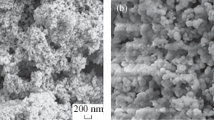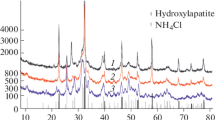Abstract
Hydroxyapatite (HA) is biocompatible with high binding activity to DNA and protein. Selenium (Se) plays a specific role in human health. Incorporation of selenium into biocompatible hydroxyapatite (HA) may endow the material with novel characteristics. in this work, a series of nano-hydroxyapatite [SeHA] powders with 1 to 5 mass-% substituted selenium were synthesised by an aqueous precipitation method using sodium selenite. The precipitates were dried at 60°C and their dried ground powders were characterised by XRD, FTIR end TEM. Substitution of Se ions took place in the crystal lattice of HA. The presence of Na ions in the hydroxyapatite was detected by XRF in all samples with selenium substituted in the lattice. No change was detected in the morphology of the rod-shaped particles, but a reduction in their size was observed as the selenium content increased. The cytotoxicity of the powders on human bone marrow mesynchymal stem cells (BM-MSCs) and umbilical cord-derived mesenchymal stem cells (UC-MSCs) was evaluated in vitro. The amount of 0.59 mM Se, corresponding to 2 mass-% substitution in the HA lsttice, did not show cytotoxicity and stimulated proliferation of UC-MSCs in contrast to pure HA powders which inhibited growth of cells. Toxicity started to appear in samples when substitution exceeded 2 mass-%. The highest concentration (5 mass-%) was severely cytotoxic. The results suggest that selenium substitution might be an attractive cell delivery modification of hydroxyapatite nanoparticles for future use in tissue engineering.
Similar content being viewed by others
References
Mostafa, A.A., Rezk, K., Dahy, T., El-Basyouni, G.: Characterization and in-vitro assessment of nano-hydroxyapatite prepared by polymeric route. Proc. 2nd Inter. Conf. and Exh. on Multifunctional Nanocomposites and Nanomaterials. Sharm El Sheikh, Egypt, January 11–13 (2008) 1–10
Rezk, K., Mostafa, A.A.: Preparation and bioactivity evaluation of hydroxyapatite titania/chitosan-gelatin polymeric biocomposites. Mater. Sci. and Eng. C28 (2008) 220–225
Yingchao Han, Shipu Li, Xianying Cao et al.: Different inhibitory effect and mechanism of hydroxyapatite nanoparticles on normal cells and cancer cells in vitro and in vivo. Scientific reports 4 (2014) Article number 7134
Adams, B., Mostafa, A.A., Schwartz, Z., Boyan, B.D.: Osteoblast response to nanocrystalline calcium hydroxyapatite depends on carbonate content. J. Biomed. Mater. Res. Part A 102 (2014) [9] 3237–3242
Mostafa, A.A., Ibrahim, D.M., Korowash, S.I., Fahim, F., Oudadesse, H.: Nanohybrid-composite scaffolds from substituted apatite/gelatin. Key Engi. Mater. 587 (2014) 233–238
Mostafa, A.A., Oudadesse, H., Mohamed, M.B. et al.: Convenient approach of nanohydroxyapatite polymeric matrix composites. Chem. Eng. J. 153 (2009) 187–192
Smith, D.K.: Calcium phosphate apatites in nature. In: Hydroxyapatite and related Materials. Edited by: Brown, P.W., Constantz, B., CRC Press, Boca Raton, USA (1994) 29–45
Carlisle, E.M.: Silicon: A possible factor in bone calcification. Science 167 (1969) 279–280
Ruys, A.J.: Silicon-doped hydroxyapatite. J. Aust. Ceram. Soc. 29 (1993) 71–80
Ghadimi, E., Eimar, H., Marelli, B., Nazhat, S.N., Asgharian, M., Vali, H., Tamimi, F.: Trace elements can influence the physical properties of tooth enamel. SpringerPlus 2 (2013) 499
Marie, P.J.: Strontium ranelate: New insights into its dual mode of action. Bone 40 (2007) S5–S8
Bowen, H.J.M.: Trace elements in biochemistry, Academic Press, San Diego (1996)
Monteil-Rivera, F., Fedoroff M., Jeanjean J., Minel L., Barthes G., Dumonceau J.: Sorption of selenite (SeO3 2−) on hydroxyapatite: An exchange process, J. Colloid Interface Sci. 221 (2000) 291–300
Steinbrenner, H., Speckmann, B., Klotz, L.O.: Selenoproteins: Antioxidant selenoenzymes and beyond. Arch. Biochem. Biophys. 595 (2016) 113–119
Wrobel, J.K., Power, R., Toborek, M.: Biological activity of selenium: Revisited. IUBMB Life 68 (2016) [2] 97–105
Czuczejko, J., Zachara, B.A., Staubach-Topczewska, E., Halota, W., Kedziora, J.: Selenium, glutathione and glutathione peroxidases in blood of patients with chronic liver diseases. Acta Biochim. Pol. 50 (2003) [4] 1147–1154
Ebert R. et al.: Selenium supplementation restores the antioxidative capacity and prevents cell damage in bone marrow stromal cells in vitro. Stem Cells 24 (2006) 1226–1235
Burke, J., Hunter, M., Kolhe, R., Isales, C., Hamrick, M., Fulzele, S.: Therapeutic potential of mesenchymal stem cell based therapy for osteoarthritis. Clin. Transl. Med. 5 (2016) [1] 27
Haldar, D., Henderson, N.C., Hirschfield, G., Newsome, P.N.: Mesenchymal stromal cells and liver fibrosis: A complicated relationship. FASEB J. 30 (2016) [12] 3905–3928
Zeng, W. et al.: Antioxidant treatment enhances human mesenchymal stem cell anti-stress ability and therapeutic efficacy in an acute liver failure model. Sci. Rep. 5 (2015) 11100, doi: 10.1038/srep11100
Bajek, A., Gurtowska, N., Olkowska, J., Kazmierski, L., Maj, M., Drewa, T.: Adipose-derived stem cells as a tool in cell-based therapies. Arch. Immunol. Ther. Exp. Warsz 64 (2016) [6] 443–454
Mrozik, K., Gronthos, S., Shi, S., Bartold, P.M.: A method to isolate, purify, and characterize human periodontal ligament stem cells. Methods Mol. Biol. 1537 (2017) 413–427
Mennan, C., Brown, S., McCarthy, H., Mavrogonatou, E., Kletsas, D., Garcia, J., Balain, B., Richardson, J., Roberts, S.: Mesenchymal stromal cells derived from whole human umbilical cord exhibit similar properties to those derived from Wharton’s jelly and bone marrow. FEBS Open Bio. 6 (2016) [11] 1054–1066
Dabrowski, F.A., Burdzinska, A., Kulesza, A., Chlebus, M., Kaleta, B., Borysowski, J., Zolocinska, A., Paczek, L., Wielgos, M.: Mesenchymal stem cells from human amniotic membrane and umbilical cord can diminish immunological response in an in vitro allograft model. Gynecol Obstet Invest. 82 (2017) [3] 267–275
Jarcho, M., Bolen, C.H., Thomas, M.B., Bobick, J., Kay, J.F., Doremus, R.H.: Synthesis and characterization in dense polycrystalline form. J. Mater. Sci. 11 (1976) 2027–2035
Ibrahim, D.M., Mostafa, A.A., Korowash, S.I.: Chemical characterization of some substituted hydroxyapatites. Chem. Centr. J. 5 (2011) 74
Bouyer, E., Gitzhofer, F., Boulos, I.: Morphological study of hydroxyapatite nanocrystal suspension. J. Mater. Sci. Mater. Med. 11 (2000) 523–531
Lafon, J.P., Champion, E., Bernache-Assollant, D.: Processing of AB-type carbonated hydroxyapatite Ca10−x(PO4)6−x(CO3)x(OH)2−x−2y(CO3)y ceramics with controlled composition. J. Europ. Ceram. Soc. 28 (2008) [1] 139–147
Suchanek, W.L., Shuk, P., Byrappa, K., Rimana, R.E., TenHuisen, K.S., Janas, V.F.: Mechanochemical-hydrothermal synthesis of carbonated apatite powders at room temperature. Biomaterials 23 (2002) [3] 699–710
Tadic, D., Peters, F., Epple, M.: Continuous synthesis of amorphous carbonated apatites. Biomaterials 23 (2002) 2553–2559
Kolmas, J., Oledzka, E., Sobczak, M., Nałęcz-Jawecki, G.: Nanocrystalline hydroxyapatite doped with selenium oxyanions: A new material for potential biomedical applications. Mater. Sci. and Eng. C39 (2014) 134–142
Ross, S.D.: Inorganic Infrared and Raman Spectra. McGraw-Hill, London (1972), ISBN: 0070941793 9780070941793
Nakamoto, K.: Infrared and Raman spectra of inorganic and coordination compounds, 4th ed. John Wiley & Sons, New York (1986), ISBN 10: 0471010669 / ISBN 13: 978-0471010661
Su, C.H., Suarez, D.L.: Selenate and selenite sorption on iron oxides: An infrared and electrophoretic study. Soil Sci. Soc. Amer. J. 64 (2000) 101–111
Remya, N.S., Syama, S., Gayathri, V., Varma, H.K., Mohanan, P.V.: An in vitro study on the interaction of hydroxyapatite nanoparticlesand bone marrow mesenchymal stem cells for assessing the toxicological behavior. Colloids and Surfaces B: Biointerfaces 117 (2014) 389–397
Abdulah, R., Miyazaki, K., Nakazawa, M., Koyama, H.: Chemical forms of selenium for cancer prevention. J. Trace Elem. Med. Biol. 19 (2005) 141–150
Yuan, Y., Liu, C., Qian, J., Wang, J., Zhang, Y.: Size-mediated cytotoxicity and apoptosis of hydroxyapatite nanoparticles in human hepatoma HepG2 cells. Biomaterials 31 (2010) 730–740
Lu, F., Wu, S.H., Hung, Y., Mou, C.Y.: Size effect on cell uptake in well-suspended, uniform mesoporous silica nanoparticles. Small 5 (2009) 1408–1413
Zhao, X., Ng, S., Heng, B.C., Guo, J., Ma, L., Tan, T.T.Y., Ng, K.W., Loo, S.C.J.: Cytotoxicity of hydroxyapatite nanoparticles is shape and cell dependent. Arch. Toxicol. 87 (2013) 1037–1052
Ma, J., Wang, Y., Zhou, L., Zhang, S.: Preparation and characterization of selenite substituted hydroxyapatite. Mater. Sci. and Eng. C 33 (2013) 440–445
Wang, Y., Ma, J., Zhou, L., Chen, J., Liu, Y., Qiu, Z., Zhang, S.: Dual functional selenium-substituted hydroxyapatite. Interface Focus 2 (2012) 378–386
Author information
Authors and Affiliations
Rights and permissions
About this article
Cite this article
Korowash, S.I., Burdzinska, A., Pędzisz, P. et al. Selenium-Substituted Hydroxyapatite Nanoparticles and their in Vitro Interaction on Human Bone Marrow- and Umbilical Cord-Derived Mesenchymal Stem Cells. Interceram. - Int. Ceram. Rev. 66, 244–252 (2017). https://doi.org/10.1007/BF03401219
Received:
Published:
Issue Date:
DOI: https://doi.org/10.1007/BF03401219




